| Cover Story
Long Distance Art
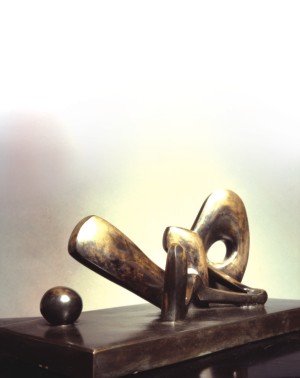
Henry Moore
Composition 1934
Bronze 19.8 x 42.5 x 20 cm
British Council Collection
For the first time in the art history of Bangladesh works of 17 modern masters of British sculpture will be displayed in the country. The exhibition titled ‘Long Distance Information’, which is going to be held in the city this month will showcase 18 works by Henry Moore, Barbara Hepworth, Anthony Caro, Barry Flanagan, Bill Woodrow, Richard Long, Mona Hatoum, Michael Craig-Martin, Richard Wentworth, Jane Simpson, Mariele Neudecker, David Shrigley, Simon Patterson, Jim Lambie, Wood and Harrison and Nathan Coley.
Organised by The British Council, in collaboration with Bengal Gallery of Fine Arts the exhibition is going to run for 17 days, it will also include education and artists in residency programmes in which Ann Elliott, a British curator will give lectures on contemporary British art, and in the eight-week-long artist-in-residency programme, two contemporary UK artists Claire Mitten and Stephanie Quayle will provide workshops to local young talents.
Ahmede Hussain
Long Distance Information
British Sculpture from the British Council Collection
Organised by the British Council, in collaboration with Bengal Gallery of Fine Arts
January 28, 2008-February 13, 2008
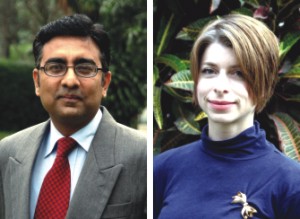 |
Syed Masud Hossain |
Claire Mitten |
The prime attraction for the Bangladeshi art lovers who are going to throng the galleries of Bengal Gallery of Fine Arts and Zainul Art Gallery will surely be Henry Moore’s 1934 work ‘Composition’. Originally done in concrete, it consists of a few bone-like forms composed together, it suggests part of a reclining figure disjointed and set anew, a theme in which Moore returned to later in his career. It is interesting to note that the year before, Moore joined Unit One, set up by English war artist Paul Nash, to “stand for the expansion of a truly contemporary spirit”. The group promoted surrealist and abstract art. At a time of ‘violent quarrel’ between ‘followers’ of Surrealism and Abstract Art, Moore said, “All good art has contained both abstract and surrealist elements, just as it has contained both classical and romantic elements--order and surprise, intellect and imagination, conscious and unconscious.” ‘Composition’, there is no doubt, reflects, this viewpoint. The display of man or human forms in the landscape, is a recurring theme in Moore’s work, explains Syed Masud Hossain, culture and science programme manager of the British Council. He says quoting the introductory notes of the exhibition that landscape and nature were fundamental and he consistently used bones, shells, stones, pebbles, flints and found pieces of wood as source material. As well as the large-scale bronze works, Moore produced carvings and incorporated modelling techniques in his work. He was also a prolific draughtsman and printmaker.
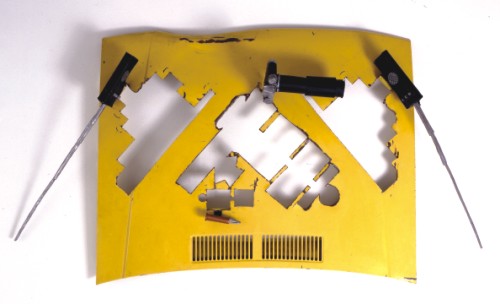
Bill Woodrow
Long Distance Information 1983
Metal and mixed media
180 x 190 cm British Council Collection
Barbara Hepworth’s ‘Maquette for Winged Figure’ (1957), also explores the relationship between figure and landscape. The pierced hole that she creates in the winged figure is characteristic of a phase of her work since 1931. She is one of the early masters to use strings in sculpture, about which the artist once famously said, “(It is to show) the tension I felt between myself and the sea, the wind or the hills.”
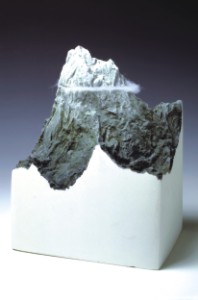 Mariele Neudecker
Mountain 1995-8, Plaster, watercolour and filter floss
27 x 19 x 13 cm, Edition of 7, British Council Collection |
The exhibition will also display ‘Table Piece’ (9176-77) by Anthony Caro, who was a part time assistant to Henry Moore when in the early 1950s he founded ‘Modernism’. It should be noted here that Caro moved on from doing figurative works after he met the American sculptor David Smith in the early 1960s, opting for sculptures welding or bolting together collections of prefabricated metal, such as I-beams, steel plates and meshes. “In a radical break with his working method Caro began to make abstract coloured sculptures which were independent of base or pedestal so that they inhabited their own space. He developed his own abstract language breaking the association of sculpture with the outside world, in particular the human figure,” Masud says. It was in 1966 the artist started working on Table Pieces’, which were actually a composition of found materials, some of which were arranged on tables, rusted, waxed or varnished. Masud explains, these were not seen as maquettes but as complete bronze works in their own right. In his work ‘Table piece CCCX’ 1976/77 he introduced elements such as handles of implements and incorporated the table to work with the sculpture rather than simply being used as a base or pedestal. The Table Sculptures represent an ongoing series of work that has continued to the present. Caro worked with lead, bronze, wood, ceramic, clay, aluminium and paper, with steel remaining his primary material.
Barry Flanagan, too, makes use of found materials, so are Jane Simpson and Bill Woodrow, while the last two use domestic objects and materials, Flanagan uses ‘poor materials’, such as sacking, flax, sand and rope. Simpson’s work witnesses an intermingling of every day objects like utensils with silicon rubber and wax. In her 'Belle' (2000) a designer Philippe Starck lamp and three tables are used with a refrigeration unit. Jim Lambie, another sculptor, uses bits and pieces from contemporary city life like mirrors, shoes, hangers, handbags, record sleeves, gloves, thread and buttons. The artist has once said, ‘covering an object somehow evaporates the hard edge off the thing, and pulls you towards more of a dreamscape. The hard, day to day, living edge disappears’. In 'Let it Bleed' and 'Micro Dot' (2001) Lambie combines music and popular culture. In Flanagan’s ‘The Cricketer’ (1979), the modelling of the original clay by hand is obvious, and in Woodrow’s ‘Long Distance Information’, which is also the title of the exhibition, a camera and a walkie-talkie are still connected to the car from which they have been severed. “It shows the ever changing nature of exchange of information in this globalised world and the advent of telephone communication, Masud says.

Simon Patterson
Wild Bill Hickock (Gunmen) 1996 Marine plywood, formica and Perspex, 121 x 34 x 244 cm, British Council Collection
Another British artist Richard Long documents his journey or ‘walks’ through the world’s hinterlands. Like the contemporary Post-modernist artists of his time Long resorts to photographs, texts and maps to depict reality. In ‘Three Moores, Three Circles’ (1982) he uses texts to describe his feeling of being in an English landscape. Like old landscape artists, the harmony between man and nature, needless to say, plays an important part in his work. Long says that he considers landscape sculptures between two ideological ends--“Making monuments”, and “Leaving only Footprints.” Photography and everyday objects find their way in Richard Wentworth’s works too, in his ‘Making do and Getting By’ (1978), colour prints made of transparency, he shows the mundane daily objects like chair and wall clock through which he depicts a bigger picture of human ingenuity and resourcefulness.
Made of nickel-plated brass pins, canvas and glue, Mona Hatoum’s ‘Prayer Mat’ (1995) has aggression and an aura of hostile quality, with a compass in the middle suggesting her dislocation and alienation. Michael Craig Martin, on the other hand, dwells on reconstruction. He explores themes of nature of art and representation. In Picturing: Iron, watch, pliers, safety-pin’ (1978), a conceptual work done on the wall, portrays mundane household object, as an artist he demands the viewer of artistic knowledge, “As opposed to an appreciation of the crafts skills, he is a propagator for the imaginative demands in art,” Masud says.

Jim Lambie
Let it Bleed 2001, Turntable, glitter, hairbands, 36 x 36 x 72 cm, British Council Collection
Micro Dot 2001, Turntable, glitter, leather belts, 36 x 36 x 72 cm, British Council Collection
Mariele Neudecker’s ‘Mountain’ (1955-8), done with pastel, watercolour and filter floss has a fairytale quality attached to it. Heavily swayed by the 19th century landscape painting, this piece pushes the tension between the landscape and reality on the brink. Done in stark green David Shirgley’s ‘New Leaf’ (1995), reclines against the wall, as though it had just been fallen from a tree. The work has humour, and a dark display of the superficiality of life. Humour is also a leitmotif in the works of Simon Patterson, who, Masud says, “Once replaced the names of stations on the London Underground map with names of philosophers, film stars, explorers, saints and celebrities.” In ‘Wild Bill Hickock’ he shows us a slide rule, which, in modern times, has been replaced by the digital calculator. The same theme is repeated in John Wood and Paul Harrison’s conceptual work ’66.86’ (2004), a looped DVD projection. It depicts a minimialist-esq white space in which a criss-cross of white ropes is pulled across the screen in a rhythm. This performance, in which the viewers are, at times, have been made aware of the artists’ presence, is repeated.
Nathan Coley’s painted harboard work Bajrakli Mosque (2007), is the most recent work of British sculpture displayed in the exhibition. And it has a story, a significant one, to tell. Built in 1575, the mosque was turned into a Catholic church in the middle of the 17th century, before the Turks returned to make it a mosque again. It now serves as the only mosque in Belgrade, Coley’s work, done in painted hardboard, plays with light, creating a pool of mirror, making it a general symbol of faith.
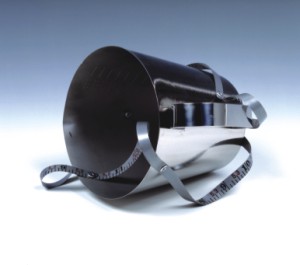
Richard Wentworth
Half a Mo 1993 Stainless steel measuring jug and tape
Diameter 45.5 cm
British Council Collection
Andrea Rose, head department of visual arts the British Council (London) thinks the exhibition traces the way in which British sculptors throughout the 20th century have sought new means through which to express themselves and the world around them. The accelerating pace of change, globalisation, the increasing flow of people and ideas into and out of Britain has all contributed to a rapidly altering landscape. British sculptors have responded to this with extraordinary vim, experimenting with forms, appropriating new materials, and irreversibly shaking up the idea that sculpture is simply the study of objects on plinths. “The aim of the exhibition and education programme,” she says, “is to develop and enhance critical dialogue, encourage open discussion and develop awareness of the environment and climate change through sculptural practise. The education programme will provide skill based workshops and lectures to enhance English language skills, written and verbal, increase knowledge of sculptural processes and techniques involving metal work; casting, incorporating recycled and industrial waste as well as use of found objects and photographic documentation work in contemporary sculpture.”
Claire Mitten, one of the artists in resident, cannot but agree. Mitten, as an artist, primarily works on found object, and she thinks that the workshops that she is going to run will provide an opportunity to exchange cultural similarities and differences surrounding the use of colour. “We will look at colour theory and differing palettes of ‘high culture’ and ‘low culture’, and the use of colour in pattern, decoration and ornamentation,” she says. Mitten will also work collaboratively with local artists in deconstructing and reconstructing to build an installation work. “It will provide an opportunity to discuss contemporary fine art practice that blurs the boundaries between disciplines and challenge ideas of permanence. It will promote discussion about process, the finished and the unfinished art-work,” she says.
In a world dangerously divided along the lines of violence, bigotry and hatred, art and literature remains the only resort for those who believe in a united happy liberal future. The exposure to contemporary British sculpture that ‘Long Distance Information’ is going to bring will surely give a boost to the country’s art scene. It will be interesting if the British Council carries on doing such cultural exchanges, art, after all, is the true voice of love.
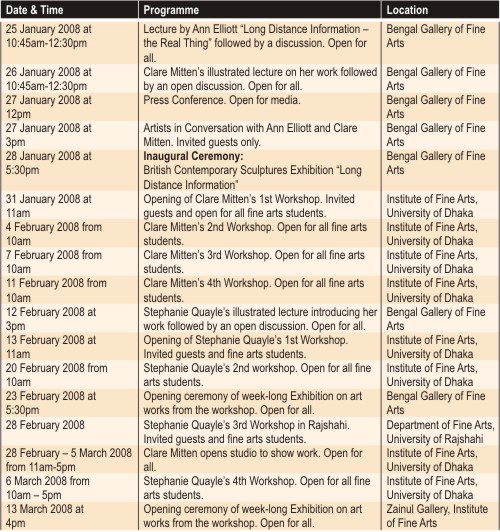
* Artists-in-residence and workshops have been organised in collaboration with the Institute of Fine Arts,
University of Dhaka and Department of Fine Arts, University of Rajshahi
Henry Moore
Henry Moore was born in Castleford, Yorkshire in 1898. He studied at Leeds College of Art where he met Barbara Hepworth and at the Royal College of Art, London where he later taught. His first solo exhibition was at the Warren Gallery, London in 1928. In 1932 he established the sculpture department at Chelsea School of Art, London. Moore moved from London to Perry Green in Hertfordshire in 1940 where he lived until his death in 1986. He was an official War Artist from 1941-45 and was awarded the International Prize at the Venice Biennale in 1948. Moore had his first London exhibition at the Tate Gallery, London in 1951, the year of the Festival of Britain. The Henry Moore Foundation was set up in 1977, a charitable organisation which still administers the allocation of grants and scholarships to promote sculpture in Britain and abroad. The Foundation recently restored Moore's house Hoglands which opened to the public in May 2007. Moore's work has been exhibited extensively and he is represented in many national collections.
Barbara Hepworth

Barbara Hepworth
Maquette for Winged Figure 1957
British Council Collection
Barbara Hepworth was born in Wakefield, Yorkshire in 1903. She won a scholarship to study at Leeds College of Art where she met Henry Moore and the following year won a scholarship to study at the Royal College of Art, London. She graduated in 1924 and was awarded another scholarship to study abroad for a year. She travelled to Italy where she stayed for two years and learnt the traditional Italian technique of marble carving. In 1934 she became a member of Unit One, a group of artists and architects based in London. She married Ben Nicholson in 1938 and they moved to St Ives, Cornwall in 1939. Hepworth exhibited widely throughout her career. She represented Britain at the Venice Biennale in 1950 and in 1959 won the Grand Prix at the 5th Sao Paulo Bienal. She had retrospective exhibitions at the Whitechapel Art Gallery, London in 1953 and 1962 as well as the Tate Gallery, London in 1968. Hepworth lived in Cornwall until her accidental death in 1975.
Anthony Caro

Anthony Caro
Table piece CCCX 1976/77, Steel
50 x 160 x 99 cm, British Council Collection
Anthony Caro was born in New Malden, Surrey in 1924. He studied engineering at Cambridge University before studying sculpture at the Regent Street Polytechnic, London and at the Royal College of Art, London 1947-1952. Caro was a part time assistant to Henry Moore from 1951-1953. He taught at St Martin's School of Art, London in the early 1950s and later 1963-1974. A number of his students were to become successful artists; Barry Flanagan, Richard Long, and Gilbert and George. He had his first solo show at Galleria del Naviligio, Milan in 1957. He represented Britain at the Venice Biennale in 1966, together with the painters; Richard Smith, Harold Cohen, Bernard Cohen and Robyn Denny and at the Sao Paulo Bienal in 1969 with the painter John Hoyland and was a prize winner on both occasions. He had his first retrospective exhibition at the Hayward Gallery, London also in 1969. Caro was knighted in 1987 and invested with the Order of Merit in 2000. He has exhibited widely and is included in many national collections. He lives and works in London.
Barry Flanagan

Barry Flanagan
Cricketer 1981, Bronze
156.2 x 39.3 x 53.4 cm, British Council Collection
Barry Flanagan was born in Prestatyn, North Wales in 1941. He studied at Birmingham College of Arts and Crafts 1957-1958 and at St Martin's School of Art, London 1964-1966 where Anthony Caro was the course tutor. He later taught at St Martin's School of Art 1967-1971. Flanagan had his first solo exhibition at the Rowan Gallery, London in 1966. He had his first retrospective exhibition at the Stedelijk van Abbemuseum, Eindhoven in 1977 which toured to the Arnolfini, Bristol and the Serpentine Gallery, London. He represented Britain at the Venice Biennale in 1982 and was elected as an Associate of the Royal Academy of Arts in 1987. His work is included in national collections and he has exhibited extensively. He lives and works in Dublin.
Bill Woodrow
Bill Woodrow was born in Henley-on-Thames, Oxfordshire in 1948. He studied at St Martin's School of Art, London 1968-1971 and at Chelsea School of Art, London 1971-1972. Woodrow had his first solo show in 1972 at the Whitechapel Art Gallery, London. In 1983 his work was included in Transformations: New Sculpture from Britain at the Sao Paulo Bienal. In 1986 he had a solo exhibition at the Fruitmarket Gallery, Edinburgh and was short listed for the Turner Prize at the Tate Gallery, London. He had a solo exhibition at the Sao Paulo Bienal in 1991. An exhibition of his bronze sculpture 'Fools Gold' was shown at the Tate Gallery, London in 1996. Woodrow has undertaken a number of major commissions, including a large bronze sculpture 'Regardless of History' for the Fourth Plinth, Trafalgar Square, London in 2000-2001. He has exhibited extensively and is represented in many national collections. He lives and works in London.
Richard Long

Richard Long
Three Moores, Three Circles 1982
Text, 103 x 153 cm, British Council Collection
Richard Long was born in Bristol in 1945. He studied at West of England College of Art 1962-1966 and at St Martin's School of Art, London 1966-1968. He had his first solo exhibition at Galerie Konrad Fischer, Düsseldorf in 1968 and represented Britain at the Venice Biennale in 1976. Major exhibitions of his work were shown at; Guggenheim Museum, New York, in 1986, Hayward Gallery, London in 1991, Kunstlammlung Nordhein-Westfalen, Düsseldorf in 1994, Setagaya Art Museum, Tokyo in 1996, the Guggenheim Museum, Bilbao in 2000 and Tate St Ives in 2002. His work was shown at the Sao Paulo Bienal in 1994 and most recently at the Scottish National Gallery of Modern Art, Edinburgh in 2007. He is included in many national collections. Long lives and works in the West of England.
Mona Hatoum

Mona Hatoum
Prayer Mat 1995
Nickel plated brass pins, compass, canvas and glue
67 x 112 x 1.5 cm, British Council Collection

Mona Hatoum was born in Beirut, Lebanon in 1952 and studied at Beirut University College from 1970-1972. She travelled to London in 1975 and stayed when civil war in the Lebanon prevented her from returning home. She studied at the Byam Shaw School of Art, London 1975-1979 and the Slade School of Fine Art, London 1979-1981. She has exhibited extensively and been included in numerous major group exhibitions. She had a solo exhibition at the Musée national d'art moderne, Centre Georges Pompidou, Paris in 1994 and was short listed for the Turner Prize at the Tate Gallery, London in 1995. Hatoum undertook a residency on the DAAD International Artists' Programme, Berlin in 2003-2004. She lives and works in London and Berlin.
Michael Craig-Martin

Michael Craig Martin
Picturing: Iron, watch, pliers, safety-pin 1978
Plastic tape, Dimensions variable
British Council Collection
Michael Craig-Martin was born in Dublin, Ireland in 1941. He studied at Yale University, USA as an undergraduate and postgraduate student 1961-1966. He taught at Bath Academy of Art 1966 -1969. His first solo exhibition was at the Rowan Gallery, London in 1969 and he was Artist-in-Residence at King's College, University of Cambridge in 1970. His work was shown with Tony Cragg in the 5th Indian Triennale in 1982. Craig-Martin has taught at Goldsmiths College, London since 1973 where Damien Hirst was a student. In 1994 he was appointed Millard Professor of Fine Arts and subsequently made Professor Emiritus of Fine Art. He curated the touring exhibition 'Drawing the Line' in 1995 and represented Britain at the Sao Paulo Bienal in 1998. He was made a CBE in 2001. Craig-Martin has exhibited extensively and has been included in major group exhibitions; 'Intelligence, New British Art', Tate Britain, London 2000 and 'Live in Your Head', Whitechapel Art Gallery, London 2000. His work is in many national collections. He lives and works in London.
Richard Wentworth
Richard Wentworth was born in Samoa in 1947. He studied at Hornsey College of Art, London 1965-1966 and at Royal College of Art, London 1966-1970. He worked as a part time assistant to Henry Moore in 1967. He had his first solo exhibition at the Greenwich Theatre Gallery in 1973 and from 1984 showed regularly at the Lisson Gallery, London. He was awarded the Mark Rothko Memorial Award in 1974. Wentworth has taught extensively including Goldsmiths College, London 1971-1987. He undertook a residency on the DAAD International Artists programme, Berlin in 1993-1994. He had major retrospectives at the Serpentine Gallery, London in 1993 and Tate Liverpool in 2005. He has exhibited extensively and has been included in many group exhibitions; 'Life/Live', Musée d'art moderne de la Ville de Paris, 'Material Culture: The Object in British Art of the 1980s and 1990s', Hayward Gallery, London. He showed in the international section 'Iconografias Metropolitas' at the Sao Paulo Bienal in 2002. His work is in many national collections. He lives and works in London.
Jane Simpson

Jane Simpson
Belle (Golden Age of Refrigeration) 2000
Philippe Starck lamp on Danish nest of tables
60 x 80 x 50 cm, British Council Collection
Jane Simpson was born in Watford in 1965. She studied at Chelsea School of Art, 1985-1988 and the Royal Academy Schools, London 1990-1993. She has exhibited extensively and was included in Damien Hirst's exhibition 'Some Went Mad, Some Ran Away' at the Serpentine Gallery in 1994. She was also in 'Sensation; Young British Artists from the Saatchi Collection', Royal Academy of Arts, London in 1997. In 1999 she was the IASPIS fellow to Goteborg. She recently had a solo exhibition 'Still Life' at the New Art Centre Sculpture Park and Gallery, Roche Court, Salisbury in 2006.
Mariele Neudecker
Mariele Neudecker was born in Düsseldorf, Germany in 1965. She studied at Goldsmiths College, London 1987-1990 and Chelsea School of Art, London 1991-1992. In 1997 she received the sculpture prize at the 7th International Biennal of Sculpture and Drawing, Gulbenkian Foundation, Lisbon. Her solo exhibitions 'Until Now' at the Ikon Gallery, Birmingham toured the UK and Germany in 2000 and 'Over and Over, Again and Again' showed at Tate St Ives and Tate Britain during 2004-2005. She recently had a solo exhibition at Bristol's City Museum and Art Gallery in 2007. She has exhibited widely and has been included in major group shows. She lives and works in Bristol.
David Shrigley

David Shrigley
New Leaf 1995, Latex and acrylic paint
90 x 60 x 1 cm, British Council Collection
David Shrigley was born in Macclesfield in Cheshire in 1968. He studied at Leicester Polytechnic 1987-1988 and at Glasgow School of Art 1988-1991. He had a solo exhibition at Transmission Gallery, Glasgow in 1995. He had solo exhibitions at The Photographers Gallery, London and Stephen Friedman Gallery, London in 1997, Surfacing Contemporary Drawing, ICA in 1998, Camden Arts Centre, London in 2002, DCA, Dundee in 2006 and recently at Stephen Friedman Gallery, London in 2007. He has exhibited extensively and has been included in major group exhibitions including 'British Art Show 5', 2000 and 'Here and Now, Scottish Art, 1990-2001' 2001. He lives and works in Glasgow.
Simon Patterson
Simon Patterson was born in Leatherhead, Surrey in 1967. He studied at Hertfordshire College of Art and Design and Goldsmiths College, London 1985-1989. He was included in Damien Hirst's exhibition 'Freeze' in 1989 and in the same year had his first solo exhibition at the Third Eye Centre in Glasgow. He has exhibited widely and in 1993 was included in the Aperto section of the Venice Biennale. In 1996 Patterson was nominated for the Turner Prize, Tate Gallery, London for his solo exhibitions at the Lisson Gallery, London and the Gandy Gallery in Prague. He had a solo exhibition at The Fruitmarket Gallery, Edinburgh in 2005. He lives and works in London.
Jim Lambie was born in Glasgow in 1964. He studied at Glasgow School of Art 1990-1994. His first solo exhibition 'Voidoid' was held at Transmission Gallery, Glasgow in 1999. He has exhibited extensively in solo and group shows including 'British Art Show 5', 2000 and 'Days Like These' at Tate Britain in 2003. He was awarded the Paul Hamlyn Foundation Award for Artists in 2000. He represented Scotland at the Venice Biennale 2003 with Claire Barclay and Simon Starling. He was short listed for the Turner Prize, Tate Britain, London in 2005. He is included in many national collections. He lives and works in Glasgow.
Wood and Harrison
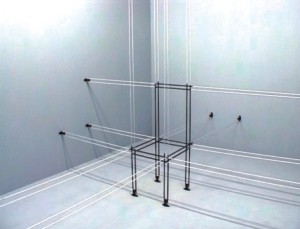
John Wood and Paul Harrison
66.86 2004 Looped DVD projection
Dimensions variable, British Council Collection
John Wood was born in Hong Kong in 1969 and Paul Harrison was born in Wolverhampton in 1966. They both studied at Bath College of Higher Education where they met and began to work collaboratively; Wood from 1988-1991 and Harrison from 1987-1990. Wood lives and works in Bristol and Harrison lives and works in London, Bristol and Wolverhampton. Wood and Harrison have exhibited extensively; two person exhibitions include 'Twenty Six (Drawing and Falling Things)', Chisenhale Gallery, London 2002, 'Notebook' Middlesborough Institute of Modern Art and Art Now / Lightbox, Tate Britain 2004. They have been included in many major group exhibitions; New British Video, MoMA, New York, 1997 and 'British Art Show 5' 2000.
Nathan Coley
Nathan Coley was born in Glasgow in 1967. He studied at Glasgow School of Art 1985-1989. His work relating to the Lockerbie Trial was included in the Tate Triennale 'Days Like These' at Tate Britain in 2003. He has had solo exhibitions at The Fruitmarket Gallery, Edinburgh, 2004, Haunch of Venison, London 2005, Jerusalem Syndrome, Cooper Gallery, University of Dundee, 2005 and he was in 'The British Art Show 6' in 2005. He had a recent solo exhibition at Mount Stuart Trust, Isle of Bute 2006. He has been short listed for the Turner Prize, Tate Liverpool 2007. Coley lives and works in Dundee, Scotland.
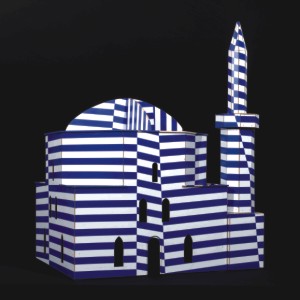
Nathan Coley
Camouflage Bajrakli
Mosque 2007
Painted hardboard
100 x 78 x 63 cm
British Council Collection
All images and biographies courtesy British Council Collection
© The Artist
Except Henry Moore, Composition 1934, on page 8 has been reproduced by permission of the Henry Moore Foundation
Copyright
(R) thedailystar.net 2008 |
